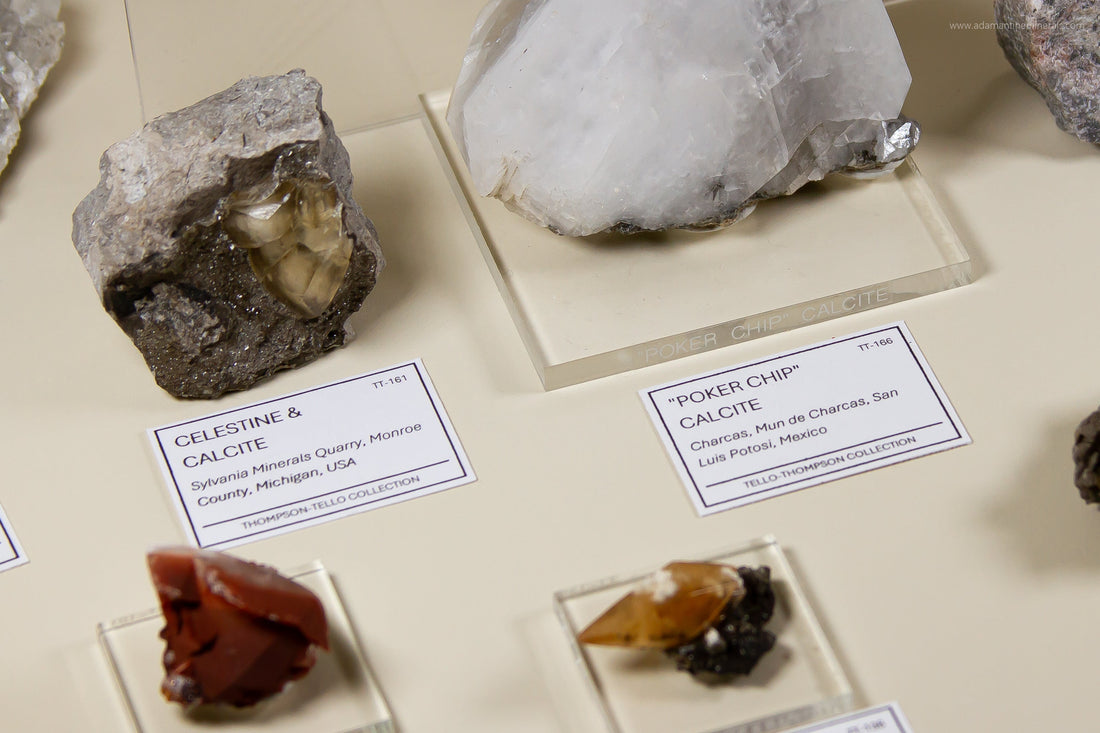
Creating Mineral Specimen Labels
Why should I label my collection?
Label cards serve as a quick informational reference for specimen details, such as mineral identification and locality. A more detailed record of each mineral specimen can be maintained and stored in a catalog.
Your labels can range from a simple piece of paper with the mineral name and locality to custom-printed cards that provide detailed information. Having both a catalog and specimen labels is the most effective way to ensure information is preserved for future generations.
Types of Labels
There are two main types of labels to consider for your collection: label cards and direct labels applied to the specimen itself. Both types are essential for proper organization and work together with your catalog to ensure each specimen is well-documented.

Label Cards
A label card is a informational card kept with its specimen as a quick reference tool. They are used to provide quick identification and documentation of each specimen.
For Display Specimens: If you're displaying a specimen, a higher-quality, visually appealing display label is recommended. These labels can be customized to match your display setup, adding both functional and aesthetic value.
For Stored Specimens: A simpler box label or catalog card can be used for specimens that aren’t on display. The label should still include essential details but may not need to be as decorative. Many specimens come with a vendor label, which works for a box label unless you want to personalize them.
Handwritten vs. Printed: For legibility, especially for display specimens, printed labels are preferable. However, if you choose to handwrite labels, make sure your handwriting is clear and easy to read.
Elements to Include:
Essential:
Mineral Name & Locality: This basic information is essential for each specimen. Be as specific with the locality as possible. If the locality is unknown, you can leave it blank or state it as “Unknown.”
Optional:
Chemical Formula: Including a chemical formula is especially useful for collections focusing on single-mineral specimens. If you're unsure about a specimen's exact species, using the mineral group name and formula (e.g., for tourmaline: XY₃Z₆(T₆O₁₈)(BO₃)₃V₃W) is an appropriate alternative.
Example: If you have a tourmaline specimen, the formula should reflect the tourmaline supergroup as a whole, not a specific species, unless you’ve had the specimen analyzed.
Ex Collection: Some collectors take interest in noting the previous owners of a specimen, such as “Ex. John Medici Collection” or “Ex. Seaman Mineral Museum.” This can add historical context to your collection.
Mining History: You may want to include the mining year or details about who mined the specimen, particularly for self-collected pieces. This information adds value, especially if the mining locality is well-known.
Simplified Chemical Groups or Crystal Class: For collectors interested in the composition or structure of minerals, consider noting whether the specimen belongs to groups like "sulfates" or "silicates." Alternatively, list the crystal class to highlight its structure.
Working in Tandem with Your Catalog:
Labels and catalogs complement each other—labels provide quick, visible references for each specimen, while catalogs store more detailed records. By including a catalog number on both your labels and in your catalog, you create a seamless system where the label acts as a quick reference and the catalog holds all additional data.
Direct Labels
In addition to label cards, each specimen should have a unique ID number attached directly to the specimen. These direct labels tie a specimen to its catalog entry or label card.
Catalog Number or Specimen ID: For larger specimens, place at least the catalog number or specimen ID directly on the specimen. This helps ensure that the specimen remains tied to its catalog entry.
Lifesaver Labels: These semi-permanent labels should include the specimen's locality, and ideally, its species and catalog number. Lifesaver labels can save a specimen from being lost in the event its label card is misplaced, especially for rare or valuable pieces.
Placement of Direct Labels:
Direct labels should be placed discreetly on the specimen, such as on the underside of a matrix or at the bottom of a specimen. It is typically recommended to use a PVA glue, so the label may be removed in the future if desired.
Why Lifesaver Labels Matter:
If a specimen becomes separated from its catalog or label card, a direct label can ensure that the essential information is preserved. Locality is often the most important detail, as it helps with identification even if the species is unclear. Lifesaver labels also help track previous ownership, which can add value to the specimen.
Final Thoughts
Proper labeling is essential for keeping your collection organized, traceable, and valuable. Whether you choose simple or detailed labels, ensure they include the key details: mineral species, locality, and a catalog number. Labels and catalogs work together, allowing you to quickly reference important information while keeping a comprehensive record of your collection’s history.
By implementing a thoughtful labeling system, you protect your specimens' integrity and ensure they can be easily identified and appreciated by future collectors.
